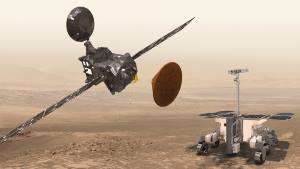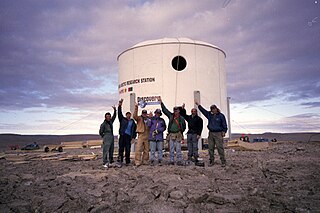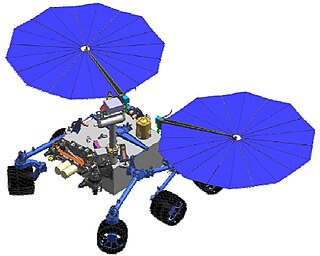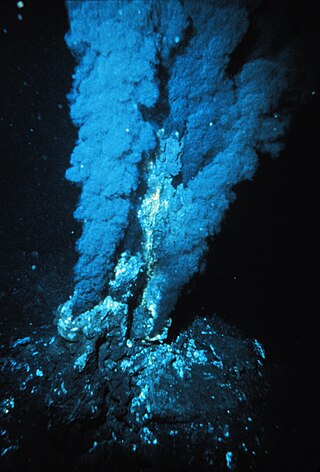Arctic Mars Analog Svalbard Expedition (AMASE) uses Mars analog sites on Svalbard for testing of science questions and payload instruments onboard Mars missions. AMASE has arranged annual expeditions on Svalbard since 2003 and is run by Vestfonna Geophysical AS and funded by the Norwegian Space Centre, ESA and NASA.
Payload instruments CheMin and SAM onboard NASA's Curiosity rover were deployed on AMASE in 2006–2011. Field deployment of payload instruments onboard ESA's ExoMars rover has been ongoing since 2007.
In 2007 ESA organized a competition, won by a student from Technical University of Denmark, which allowed the winner to carry out her own experiment during the expedition as well as assist in other experiments and activities. [1] [2]

Mars Express is a space exploration mission being conducted by the European Space Agency (ESA). The Mars Express mission is exploring the planet Mars, and is the first planetary mission attempted by the agency. "Express" originally referred to the speed and efficiency with which the spacecraft was designed and built. However, "Express" also describes the spacecraft's relatively short interplanetary voyage, a result of being launched when the orbits of Earth and Mars brought them closer than they had been in about 60,000 years.

The Beagle 2 is an inoperative British Mars lander that was transported by the European Space Agency's 2003 Mars Express mission. It was intended to conduct an astrobiology mission that would have looked for evidence of past life on Mars.

The planet Mars has been explored remotely by spacecraft. Probes sent from Earth, beginning in the late 20th century, have yielded a large increase in knowledge about the Martian system, focused primarily on understanding its geology and habitability potential. Engineering interplanetary journeys is complicated and the exploration of Mars has experienced a high failure rate, especially the early attempts. Roughly sixty percent of all spacecraft destined for Mars failed before completing their missions and some failed before their observations could begin. Some missions have met with unexpected success, such as the twin Mars Exploration Rovers, Spirit and Opportunity which operated for years beyond their specification.

Phoenix was an uncrewed space probe that landed on the surface of Mars on May 25, 2008, and operated until November 2, 2008. Phoenix was operational on Mars for 157 sols. Its instruments were used to assess the local habitability and to research the history of water on Mars. The mission was part of the Mars Scout Program; its total cost was $420 million, including the cost of launch.

ExoMars is an astrobiology programme of the European Space Agency (ESA).

The Flashline Mars Arctic Research Station (FMARS) is the first of two simulated Mars habitats located on Devon Island, Nunavut, Canada, which is owned and operated by the Mars Society. The station is a member of the EU-INTERACT, circumarctic network of currently 89 terrestrial field bases located in northern Europe, Russia, US, Canada, Greenland, Iceland, the Faroe Islands, and Scotland as well as stations in northern alpine areas.

The Lab-on-a-Chip Applications Development (LOCAD) element is a set of related lab-on-a-chip projects at NASA. The projects develop integrated lab-on-a-chip products in three areas related to space exploration: Environmental Control and Life Systems Support (ECLSS), Medical Systems, and Remote Exploration. NASA conducts activities related to these projects both at NASA Marshall Space Flight Center and aboard the International Space Station (ISS).

The ExoMars Trace Gas Orbiter is a collaborative project between the European Space Agency (ESA) and the Russian Roscosmos agency that sent an atmospheric research orbiter and the Schiaparelli demonstration lander to Mars in 2016 as part of the European-led ExoMars programme.

The Mars Astrobiology Explorer-Cacher (MAX-C), also known as Mars 2018 mission was a NASA concept for a Mars rover mission, proposed to be launched in 2018 together with the European ExoMars rover. The MAX-C rover concept was cancelled in April 2011 due to budget cuts.

Astrobiology Science and Technology for Exploring Planets (ASTEP) was a program established by NASA to sponsor research projects that advance the technology and techniques used in planetary exploration. The objective was to enable the study of astrobiology and to aid the planning of extraterrestrial exploration missions while prioritizing science, technology, and field campaigns.
Human analog missions are activities undertaken on Earth in various environments to simulate aspects of human missions to other worlds, including the Moon, asteroids, and Mars. These remote field tests are performed in locations that are identified based on their physical similarities to the extreme space environments of a target mission. Such activities are undertaken to test hardware and operational concepts in relevant environments.

Vladimir Pletser is Visiting Professor – Scientific Adviser at the Technology and Engineering Centre for Space Utilization (CSU) of the Chinese Academy of Sciences in Beijing, China, since April 2016. He supports the preparation of scientific experiments in microgravity for the future Chinese Space Station and for aircraft parabolic flights. He worked previously from 1985 till early 2016 as senior Physicist-Engineer at the European Space Research and Technology Centre (ESTEC) of ESA.
Rosalind Franklin, previously known as the ExoMars rover, is a planned robotic Mars rover, part of the international ExoMars programme led by the European Space Agency and the Russian Roscosmos State Corporation. The mission was scheduled to launch in July 2020, but was postponed to 2022. The 2022 Russian invasion of Ukraine has caused an indefinite delay of the programme, as the member states of the ESA voted to suspend the joint mission with Russia; in July 2022, ESA terminated its cooperation on the project with Russia. As of May 2022, the launch of the rover is not expected to occur before 2028 due to the need for a new non-Russian landing platform.

Schiaparelli EDM was a failed Entry, Descent, and Landing Demonstrator Module (EDM) of the ExoMars programme—a joint mission of the European Space Agency (ESA) and the Russian Space Agency Roscosmos. It was built in Italy and was intended to test technology for future soft landings on the surface of Mars. It also had a limited but focused science payload that would have measured atmospheric electricity on Mars and local meteorological conditions.

The ExoMars Kazachok was a planned robotic Mars lander led by Roscosmos, part of the ExoMars 2022 joint mission with the European Space Agency. Kazachok translates as "Little Cossack", and is also the name of a folk dance.

MicrOmega-IR is an infrared hyperspectral microscope that is part of the science payload on board the European Rosalind Franklin rover, tasked to search for biosignatures on Mars. The rover is planned to land on Mars in the mid- or late 2020s. MicrOmega-IR will analyse in situ the powder material derived from crushed samples collected by the rover's core drill.
ADRON-RM is a neutron spectrometer to search for subsurface water ice and hydrated minerals. This analyser is part of the science payload on board the European Space Agency'sRosalind Franklin rover, tasked to search for biosignatures and biomarkers on Mars. The rover is planned to be launched in August–October 2022 and land on Mars in spring 2023.
CLUPI is a miniaturized camera system on board the planned European Space Agency Rosalind Franklin rover. CLUPI was designed to acquire high-resolution close-up images in colour of soils, outcrops, rocks, drill fines and drill core samples, as well as and the search for potential biosignature structures and patterns. This camera assembly is part of the science payload on board the European Space Agency'sRosalind Franklin rover, tasked to search for biosignatures and biomarkers on Mars. The rover is planned to be launched in August–October 2022 and land on Mars in spring 2023.

Perseverance, nicknamed Percy, is a car-sized Mars rover designed to explore the Jezero crater on Mars as part of NASA's Mars 2020 mission. It was manufactured by the Jet Propulsion Laboratory and launched on July 30, 2020, at 11:50 UTC. Confirmation that the rover successfully landed on Mars was received on February 18, 2021, at 20:55 UTC. As of 19 March 2023, Perseverance has been active on Mars for 738 sols since its landing. Following the rover's arrival, NASA named the landing site Octavia E. Butler Landing.